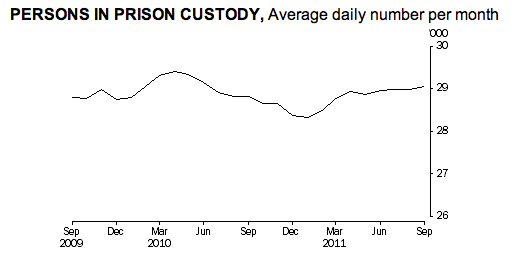The ABS released their Corrective Services statistics yesterday. Below is a key chart showing the relatively flat prisoner numbers. Indeed Australia’s imprisonment rate has barely notched up since 2001, and compares favourably in global comparisons.
While very positive, this data provides an opportunity to reflect on the role of prisons in society. Recently, the discussion surrounding imprisonment has become focussed on rehabilitation, using recidivism rates inappropriately as a statistical measuring stick of success. This seems to be the product of confusing success in parenting with success in crime prevention.
For seasoned criminals one must ask whether rehabilitation is genuinely the purpose of imprisonment. Surely, a more effective way to rehabilitate offenders would to have a wholesome family adopt them into their home and demonstrate law abiding ways to live and prosper. Imprisonment with other criminals for an extended period seems strongly counterproductive to a shift to a more law-abiding lifestyle.
As one insightful commenter noted here, even low rates of recidivism would be not be a signal of the success of imprisonment because they can be caused by factors other than reform or a desire ‘not to go back there.’
- Crime is committed mostly by young men. As a man gets older, he’s less likely to reoffend.
- Crime is sometimes committed as a one-off event (such as crimes of passion, or rare opportunity). These are unlikely to be repeated.
- Convicts are sometimes innocent. These people, too, are unlikely to reoffend.
Clearly, the function of imprisonment is to act as a deterrent to all potential criminals, not just to those who have already been imprisoned (as well as isolating offenders from society for a period to prevent repeat offence). This is quite different to punishments set by parents for their children, where there purpose is twofold – prevention of initial offence of a single child (or few children), plus a deterrent to future offences, or what is better described as rehabilitation.
Recidivism rates after punishment are important for parents. Repeat offences by children (it sounds odd to say it like that) signal that the punishment was not appropriate for either the initial prevention, or rehabilitation. For parents to encourage appropriate behaviour in their children they need to adapt their punishments so that each child will respond to them. There is usually no one-size-fits-all approach.
With criminals, punishment needs to be a one-size-fits-all approach, and if that is insufficient to prevent some crime, then those individuals will have to accept that punishment, often repeatedly. There is little scope, unlike parenting, to adopt individual punishment regimes to rehabilitate the whole criminal populous.
I want to leave you with an excerpt on the inappropriate use of recidivism rates to evaluate the effectiveness of imprisonment from this article.
This is a peculiar objection to imprisonment—rather like complaining that your TV is not working because it does not defrost chickens. Reducing repeat offending is not the purpose of prison. Its purpose is to reduce offending. It does this in two ways: by deterring people from committing crimes and by positively preventing them from doing so while they are inside.
But doesn’t the high recidivism rate show that prison is not an effective deterrent after all? It does not. Testing the deterrence effect of prison by observing the proportion of ex-prisoners who commit crimes is a bad case of the statistical error of “sample bias.” Prisoners are, by hypothesis, people for whom the threat of prison is an insufficient deterrent to crime. That prison does not deter ex-prisoners tells us nothing about how much it deters the rest of the population, nor therefore by how much it reduces crime.
Once you think of criminal punishments as deterrents, 100% recidivism is unsurprising, because the first conviction is the most expensive for a criminal. This is when he incurs the one-off, irrecoverable costs of becoming a known criminal, such as diminished career and social prospects. If the chance of incurring these costs (in addition to the penal costs) did not deter him from committing a crime, then the inevitably lesser costs of subsequent convictions are unlikely to deter him. This is true whatever the legal penalty for crime—be it torture, prison or “community service”—and however effectively it deters first crimes. Recidivism is a red-herring.
Alas, those who complain about recidivism do not think of imprisonment as a deterrent. They think of it as being more like a medical treatment, aimed at “rehabilitating” people who have succumbed to a behavioral disease that they caught from our unhealthy society or, perhaps, from their genetic inheritance.
There is, of course, much more to the story. Threats of punishment are just one of many motivations for behaviour, and like parenting, this approach needs to be balanced with a variety of ways of promoting acceptable behaviour. Understanding the role of imprisonment in society is a key requirement for a proper understanding of the statistics, and I am sure there is still much debate to be had in this area.
Tips, suggestions, comments and requests to [email protected] + follow me on Twitter @rumplestatskin
